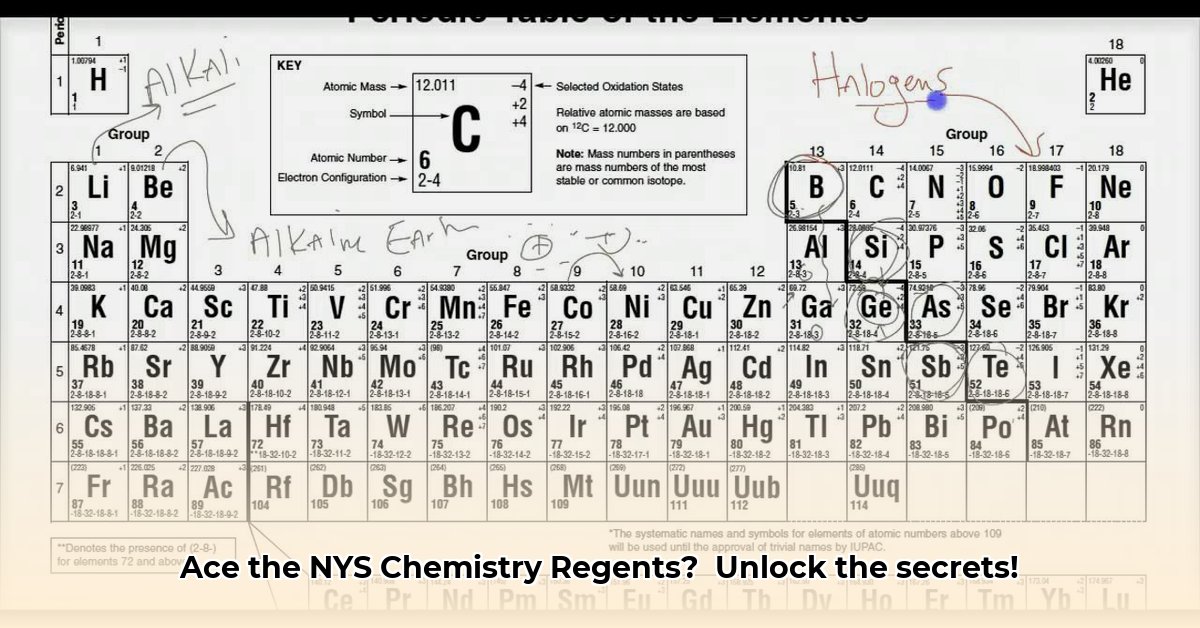
Understanding the NYS Chemistry Regents Reference Tables: A Comprehensive Guide
The New York State Chemistry Regents exam can feel daunting, but mastering the reference tables is your key to unlocking success. This isn't just about memorizing; it's about understanding how to use these tables effectively to solve problems quickly and confidently. This guide provides a step-by-step walkthrough, addressing common challenges and offering practical strategies for exam day. Are you ready to transform your approach to the Regents exam? For extra practice, check out this helpful online reference table.
A Historical Overview and Current Challenges
The NYS Chemistry Regents Reference Tables have evolved over time, reflecting changes in the curriculum and pedagogical approaches. While these updates aim to improve clarity and accessibility, they've also introduced some minor inconsistencies. For example, variations in formatting exist between different versions of the tables, and occasional software compatibility issues may arise when accessing older scoring materials. This guide will address these challenges, providing solutions and strategies for a smooth exam experience. Did you know that the format of the scoring materials has varied over the years, sometimes impacting software compatibility? This is a common challenge we'll address directly.
Part 1: Demystifying the Tables: A Visual Walkthrough
The reference tables are organized into various sections, each serving a specific purpose. Let's explore some key sections:
Table 1: General Information: This is your primary resource, providing essential data for a wide range of chemistry problems. Consider it your central hub for constants, formulas, and critical information. Familiarize yourself with its sub-sections to easily locate the information relevant to each problem.
Table F: Solubility: This table is crucial for predicting whether a substance will dissolve in water, a fundamental concept in many chemistry reactions. Mastering this table will significantly enhance your ability to predict reaction outcomes.
Table B: Specific Heat: Understanding specific heat is essential for solving problems involving heat transfer. This table allows for the calculation of heat absorbed or released during a chemical or physical change. Practice these calculations until they become second nature.
Other Tables: Don't overlook other tables! Each contains crucial information relevant to specific topics covered on the exam. Explore all the tables to fully understand their content and function.
Part 2: Mastering the Tables: Practical Strategies and Tips
Effective use of the reference tables is crucial for success. Here’s a breakdown of actionable steps:
Pre-Exam Scan: Before starting the exam, quickly review all the tables. This familiarization will improve your speed and efficiency during the actual exam.
Targeted Approach: Identify the relevant table(s) before attempting to solve a problem. This targeted approach avoids wasted time and reduces stress.
Unit Conversion Mastery: Pay close attention to units! Inaccurate unit conversions are a common source of errors. Double-check your units to ensure accuracy.
Consistent Practice: Regular practice is key. Use past Regents exams and practice problems to simulate the exam environment and improve your speed and accuracy. Timed practice is highly beneficial.
Addressing Version Inconsistencies: While slight variations in formatting might occur across different versions of the tables, understanding and practicing with a few versions will eliminate any surprise during the exam.
Troubleshooting Software Compatibility: Ensure your PDF reader and other software are compatible with the official exam documents before exam day. This prevents unforeseen technical disruptions.
Sample Problem & Solution: Applying Your Knowledge
Let's consider a question requiring the calculation of the heat released during a reaction. First, you would identify the relevant values (specific heat, mass, and temperature change) using Table B. Then, using the appropriate equation from Table T, perform the calculation, paying close attention to unit consistency and conversion, as necessary.
Overcoming Challenges: Software Compatibility and Version Differences
The New York State Education Department (NYSED) website (https://www.nysedregents.org/Chemistry/) is the official source for past exams and scoring materials. However, older materials may present compatibility challenges. If you encounter difficulties with older files, try updating your software or contacting NYSED for assistance. Remember that utilizing different versions of the reference tables to practice might reveal subtle differences in formatting. Adapting to these differences beforehand will prevent any unexpected obstacles during the actual exam. Consistent practice using different versions will vastly improve your familiarity and proficiency.
Key Takeaways:
- Mastering the NYS Chemistry Regents Reference Tables is essential for exam success.
- Consistent practice under timed conditions is crucial.
- Addressing software compatibility and version differences in advance will ensure a smooth exam experience.
This guide empowers you to approach the NYS Chemistry Regents exam with confidence and competence. Remember, consistent practice and a thorough understanding of the reference tables are your keys to success!